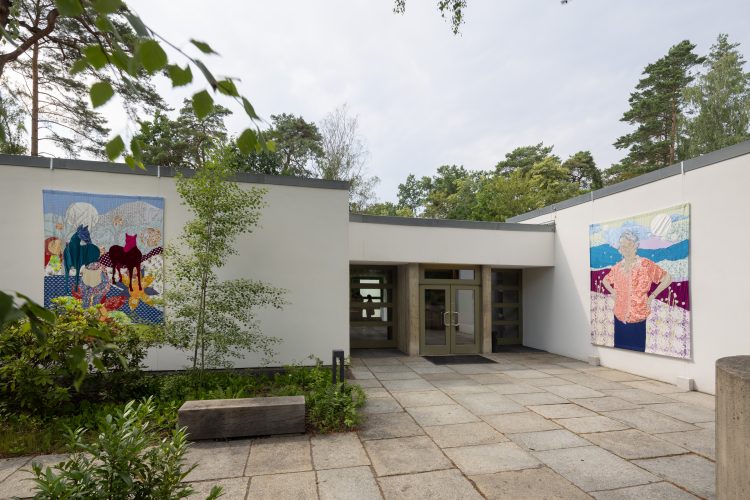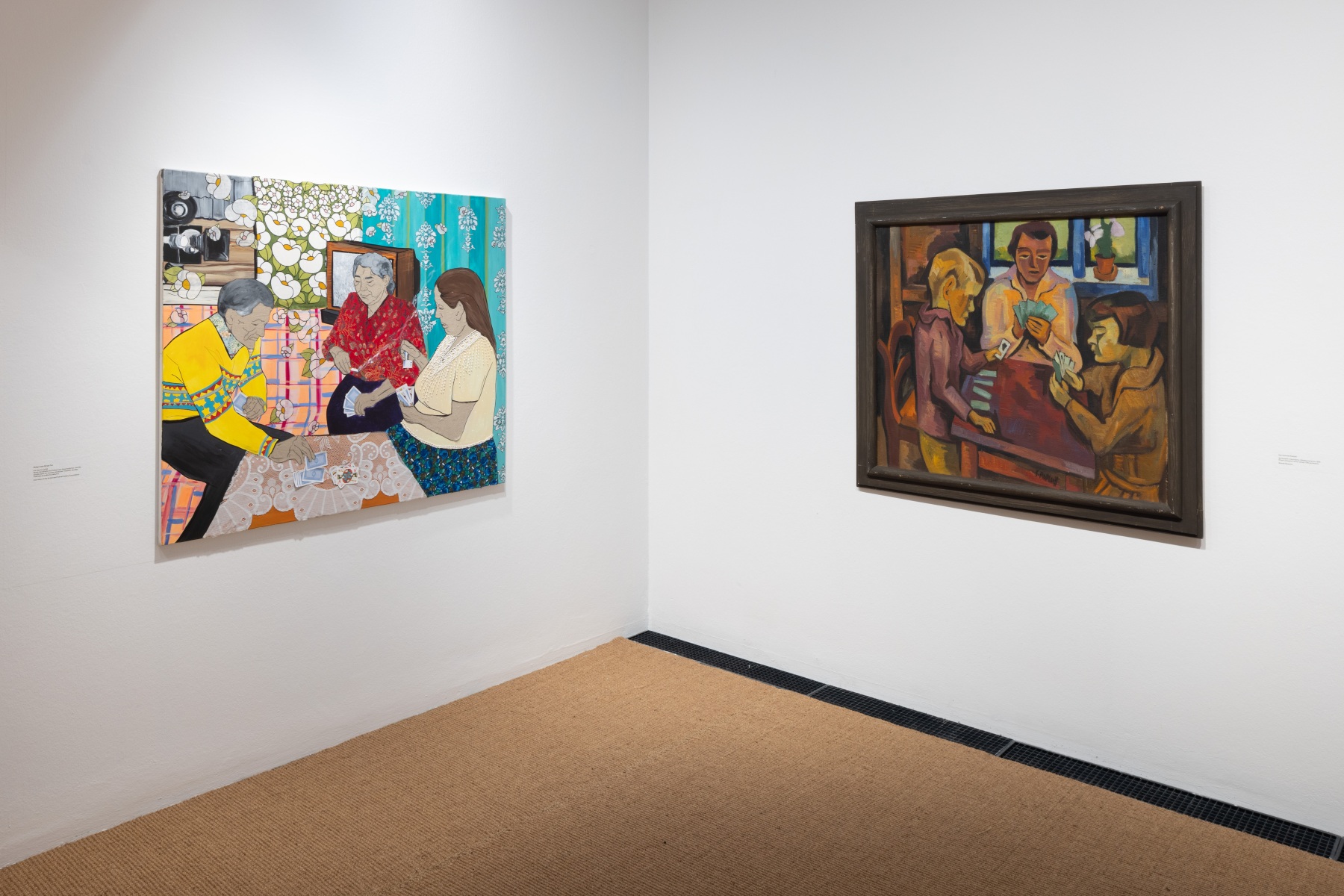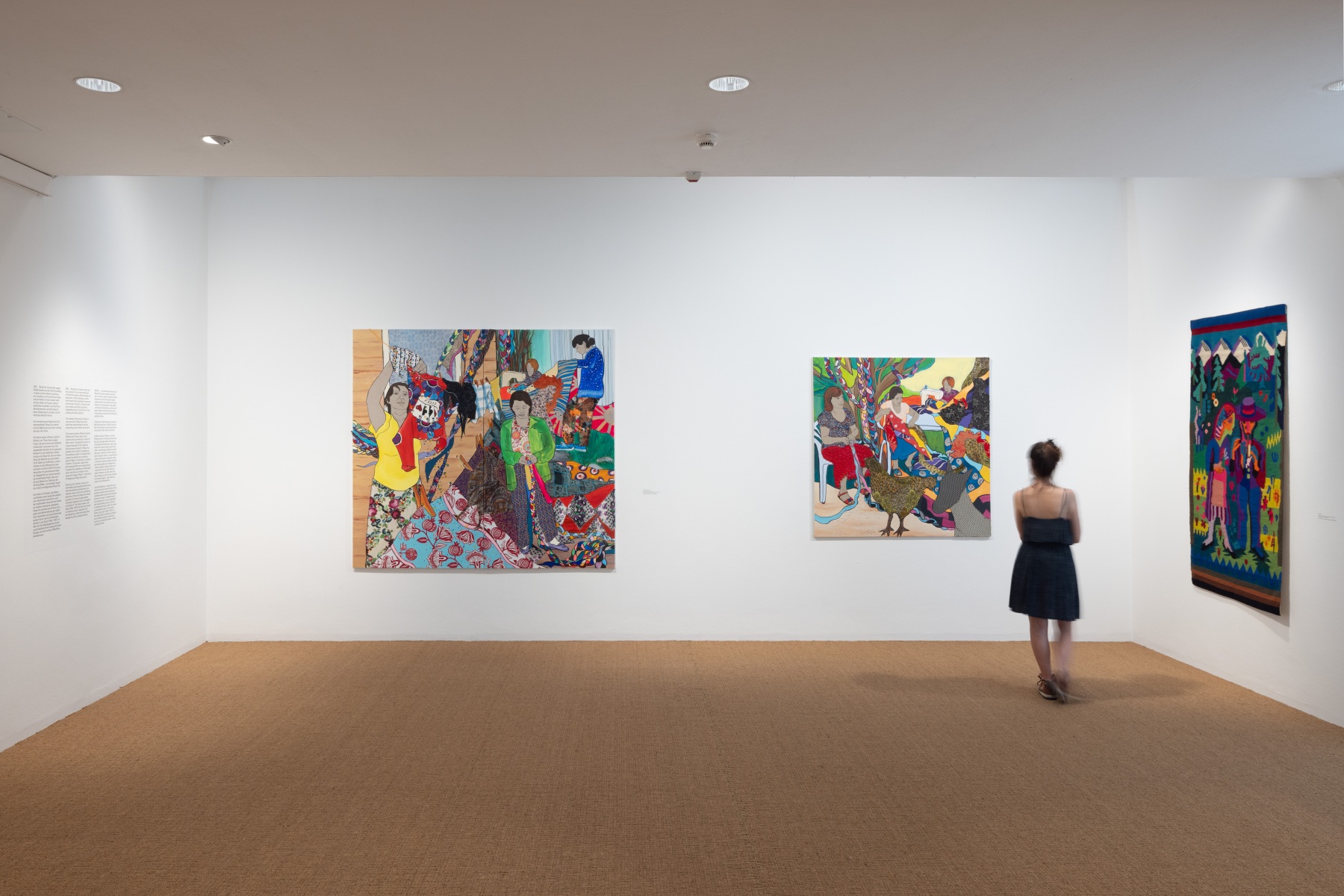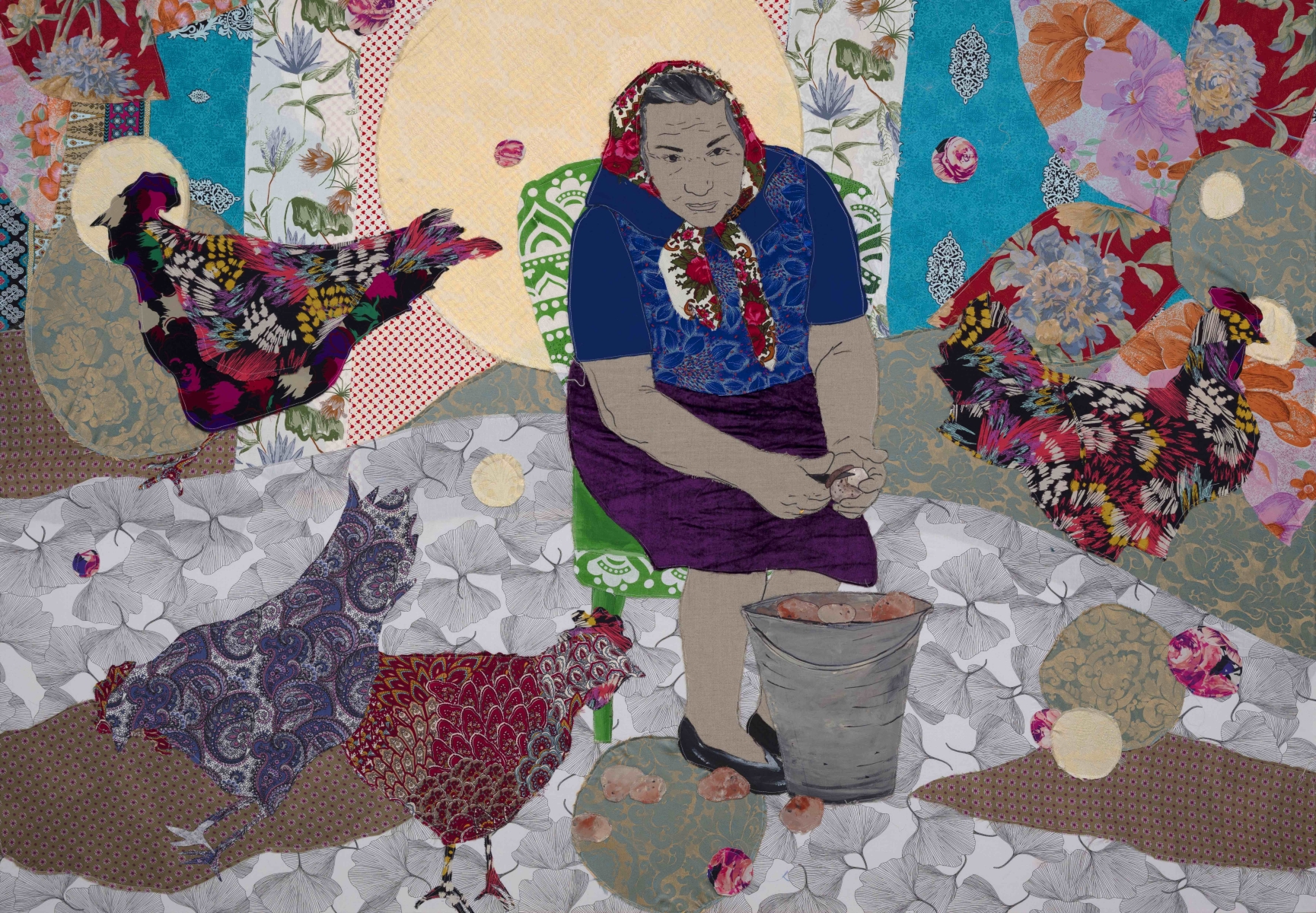”I SEWED FOR US” – RomaMoMA IN CONVERSATION WITH LISA MAREI SCHMIDT, DIRECTOR OF THE BRÜCKE MUSEUM

Małgorzata Mirga-Tas: Sivdem Amenge / Ich nähte für uns / I sewed for us, Brücke-Museum, 2023, exterior view. Photo: Thomas Bruns
The exhibition, Sivdem Amenge / I sewed for us / Ich nähte für uns, with works by Polish-Romani artist Małgorzata Mirga-Tas was on view from 26 June till 3 September 2023 at the Brücke Museum in Berlin. RomaMoMA interviewed Lisa Marei Schmidt, Director of the Brücke Museum, for the occasion.
RomaMoMA: You are director of the Brücke Museum in Berlin, which hosts the largest collection of Brücke art in the world. Please, tell us more about the Museum and its collection.
Lisa Marei Schmidt: The Brücke Museum was initiated by the artist Karl Schmidt-Rottluff and is dedicated to the artist group Brücke (bridge). This group was founded in Dresden in 1905 by Schmidt-Rottluff, together with Ernst Ludwig Kirchner, Erich Heckel and Fritz Bleyl. Later members were Max Pechstein, Emil Nolde and Otto Mueller. They worked together until 1913 and are today considered the beginning of Expressionism in Germany. As you said, we hold at the museum one of the largest collections of their works worldwide, around 5000 paintings, drawings, prints and sculptures. The museum opened in 1967 in a simple, but beautiful Modernist building by Werner Düttmann, on a large forest property, in the Grunewald, which was then in West Berlin.
RomaMoMA: You refer to the Museum as a collection-based research institution. Can you elaborate on this, and where your research is directed?
Lisa Marei Schmidt: I feel strongly that with a collection that has such a dedicated focus, we need to be a research institution. Our research concerns all questions related to the artists and the works in our collection. We also aim to ask and address questions which are relevant for us today, in contemporary society.
RomaMoMA: What is your vision as a curator and as director of the Brücke Museum?
Lisa Marei Schmidt: My vision is to connect our historical and exclusively male collection with contemporary questions, and to broaden the perspective on our collection. The beauty of my job is that I can invite or host other artists, as well as other institutions, and other ideas, and to welcome new approaches to curating and surveying and re-contextualising this historic collection.
Lisa Marei Schmidt: We always try to incorporate different perspectives, and for almost every exhibition, we work with outside experts, who might be an artist, an academic, a community, or a craftsperson (e.g., we organised a fantastic exhibition on Brücke frames with Werner Murrer, a frame-maker from Munich). For her exhibition, Gosia wanted to invite Anna Mirga-Kruszelnicka and Hamze Bytyçi to think about the programme together with us. Daniela Bystron, our curator of outreach, was in this case more of a facilitator than a curator, realising Anna’s and Hamze’s ideas, and the museum was the venue to provide a space for their ideas. This is one of Daniela’s favourite ways of working, with the museum as a site that others can use, a space that we can provide for other ideas or programmes. In the case of Gosia’s exhibition, I felt that this was also an amazing opportunity to share critical questions on some of the works of Otto Mueller. As a public cultural institution, it is our responsibility to expose and critically question traditional racist stereotypes, which are still prevalent today and can be found in some of the works in our collection. It is wonderful to see how Małgorzata transforms in her works these external stereotypes and counters them with a new, self-confident Romn*ja iconography.
RomaMoMA: Considering the paintings of Otto Mueller, how did you decide to invite contemporary Romani artists, such as Małgorzata Mirga-Tas, to engage with the depictions of this celebrated Modernist painter?
Lisa Marei Schmidt: I saw Małgorzata’s work in Venice and immediately fell in love with it. She is an amazing artist, and I wanted to show her work in dialogue with our collection, not only in a critical reflection on Otto Mueller (in the final gallery of the exhibition), but my goal was to embed her into an art historical canon (I know that this word is highly problematic), in the tradition of Genre paintings of modern art.
RomaMoMA: I Sewed for Us is not the first exhibition where you invited contemporary artists to reflect on the museum collection. Please share some insights on previous experiences.
Lisa Marei Schmidt: My background is in contemporary art, so since the beginning, I have been interested in inviting contemporary artists to the Brücke Museum. The invitation is to enter into a dialogue with our collection. As we are not a white cube exhibition space, but a museum dedicated to historic works, I feel that this dialogue is of vital importance. The first artist we worked with was Sol Calero, who built a beautiful pavilion in our garden, which was a three-dimensional painting and opened the outside of the museum to the public for the first time. The first artist who had an exhibition inside with our collection was Vivian Suter, whose installation can be described as a wild garden or jungle of free-hanging canvases inside the gallery space, in which the visitor could discover works from our collection.
RomaMoMA: What was your working method with Małgorzata Mirga-Tas?
Lisa Marei Schmidt: I loved working with Małgorzata Mirga-Tas! Together with Melanie Roumigiere (Head of the Berlin artist programme at DAAD), who co-curated this exhibition, we began the dialogue with her about existing works that we wanted to show. We made the conscious decision to show works from the last 10 years, so that you can get an overview of her practice and artistic development. Then Gosia looked at our collections and drew inspiration from them. At the same time, she also started to research the historic situation of Romn*jna and Sinti*zze in Berlin, as she always tries to reflect on the historic situation of a place with new works. Ultimately, she created nine new works for this show, which was amazing.
RomaMoMA: How did you reach your selection of which artworks from the collection to include in the exhibition (not only Roma-themed, but landscapes, still lives, etc.)?
Lisa Marei Schmidt: It was a conversation with Gosia, and in the end, she decided what she wanted to show together with her own works. There were some paintings that she loved from the start, like Cuno Amiet’s painting of horses, and others, such as Dead Chickens, a painting from 1908, by Erich Heckel, which I introduced to her, after seeing the images of her mother and grandmother with chickens.
RomaMoMA: The curatorial decision was finally not to exhibit the paintings of Otto Mueller: they are somehow hidden from the viewers, while Gosia’s paintings are in the spotlight, speaking from the authentic, self-determined viewpoint of a Roma woman. How did you arrive to this decision? How do you find these entry points to work with a heavy legacy, and show the problematic elements in it, while not entirely censoring the past?
Lisa Marei Schmidt: It involved a lot of conversation, and it was not easy at times. I thought of the dialogue of Gosia’s reflection on a motif of Otto Mueller. The work in question is a lithograph which is part of his Z*** Portfolio of 1927, depicting two (half-nude) women in an interior. After seeing this image, Gosia told me that Romni would never have themselves portrayed as nudes: it is a still a quite conservative community, and nudity is not typical. She then created a portrait of two Romni women, her mother and her sister, in an interior, drinking coffee. This work, in a way, tells everything it needs to, and makes the stereotypical and highly racist view of Romn*ja completely clear. Gosia did not want to have this as a direct dialogue, as she found this image of Otto Mueller highly problematic and still hurtful, and for me it was important to respect this.
RomaMoMA: You not only decided to keep the artworks of Otto Müller away from the visitors’ eyes, but consciously chose to use the term Roma in your texts, references, programme descriptions, etc. Can you explain this very conscious choice of words?
Lisa Marei Schmidt: Words and language possess a huge power: they manifest hierarchies and ideas, and we discuss our use of language quite a lot. We did some critical investigations into the Nazi period, as well as into Colonialism and Brücke, where we started the discussion around language and the words used. Often just using different words or gendering initiates a huge debate, which I find very important. Language is constantly changing; it is not something static, but it reflects a state of mind. We always include others in this discussion; for example, it was Gosia’s idea to have the entire exhibition in three languages: German, English and Romani. And not writing out racist or discriminatory titles is a conscious decision to not renew hurt or racism.
Lisa Marei Schmidt: I think we have a great responsibility, as we will either perpetuate or break stereotypical views and narratives.
***In Romani language, Rom (singular) means man or human; Roma is the plural form. This text uses the term “Roma” as an all-encompassing term used to describe all groups of the European minority who share Romani heritage. The term “Sintizze” is a self-ascription of the Romani subgroup resident in Germany and a number of other German-speaking areas. The term “Z***” is considered a racist, prejudiced and pejorative external designation created by the non-Roma majority to refer to the Roma. The text uses this word exclusively for the titles of works assigned by Mueller himself and where it serves to distinguish the population of Roma from the constructed stereotypes. Out of respect to Roma, and in order to avoid acceptance, we have decided to use a self-censored writing “G***” and “Z***”, to clarify that this word is inappropriate and problematic.







Leave a Reply